Analyzing Leadership: Styles, Self-Efficacy, and Organizational Impact
VerifiedAdded on 2023/06/18
|12
|3294
|64
Homework Assignment
AI Summary
This assignment provides a detailed exploration of various leadership styles, including situational, transactional, and transformational leadership. It discusses the importance of transformational leadership for organizational functioning and examines the behaviors exhibited by transformational leaders. The concept of self-efficacy is defined, and strategies for increasing personal effectiveness as a leader are outlined. Furthermore, the qualities associated with servant leadership, such as empathy, listening, and persuasion, are discussed. The assignment also delves into essential organizational competencies, including time management, goal setting, planning, communication, and employee evaluation, highlighting their significance for effective leadership and organizational success. This comprehensive analysis offers valuable insights into the multifaceted nature of leadership and its impact on organizational dynamics.
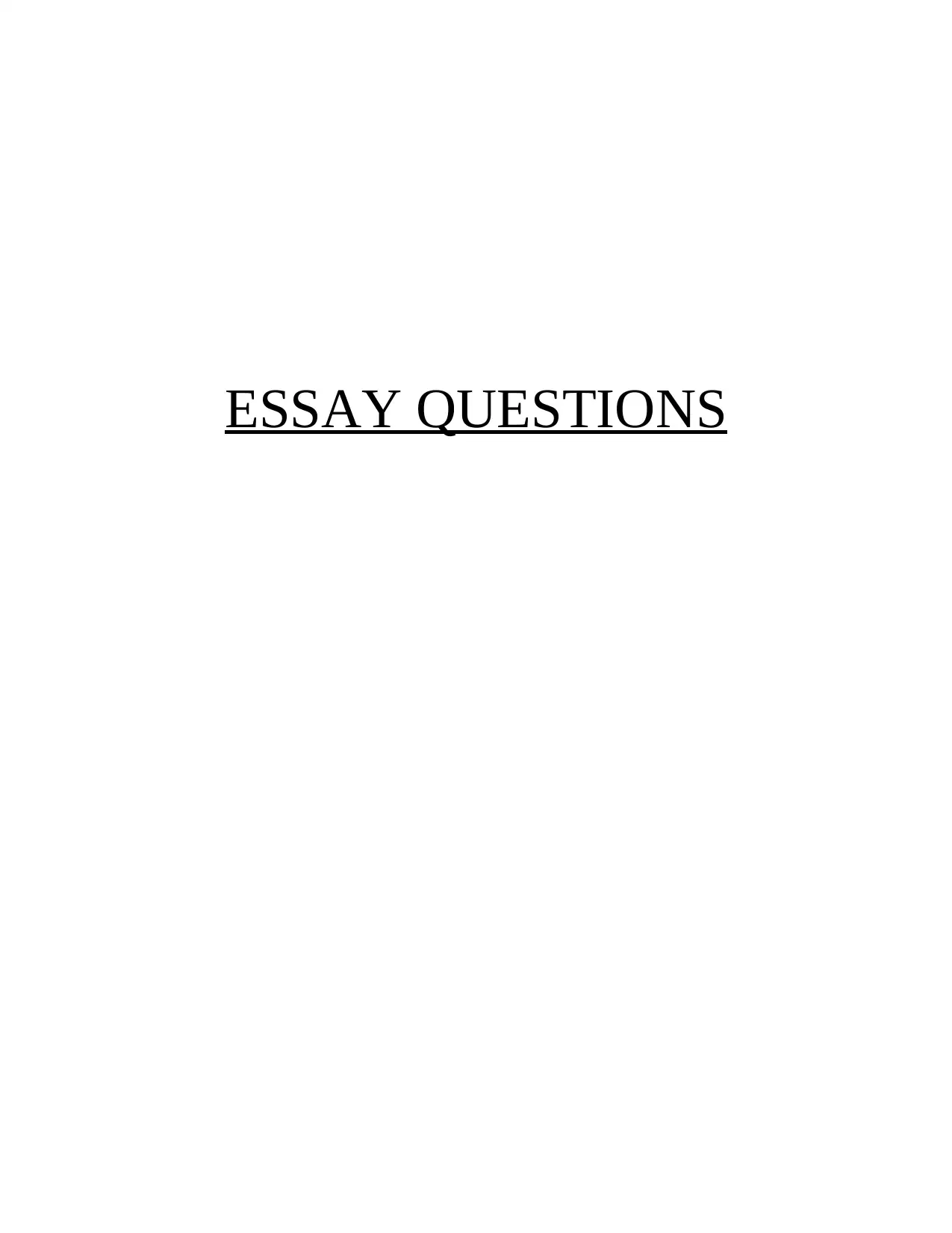
ESSAY QUESTIONS
Paraphrase This Document
Need a fresh take? Get an instant paraphrase of this document with our AI Paraphraser
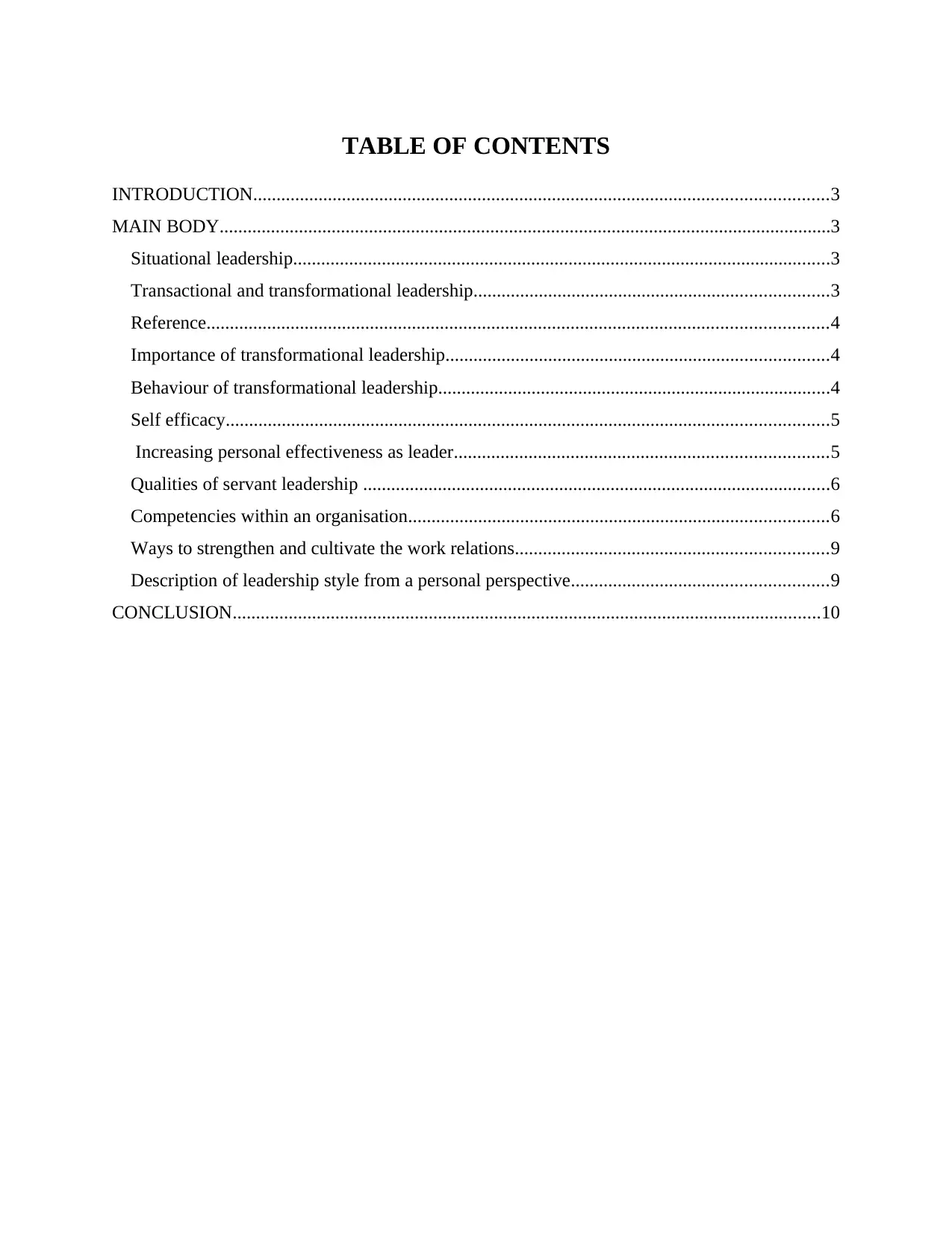
TABLE OF CONTENTS
INTRODUCTION...........................................................................................................................3
MAIN BODY...................................................................................................................................3
Situational leadership...................................................................................................................3
Transactional and transformational leadership............................................................................3
Reference.....................................................................................................................................4
Importance of transformational leadership..................................................................................4
Behaviour of transformational leadership....................................................................................4
Self efficacy.................................................................................................................................5
Increasing personal effectiveness as leader................................................................................5
Qualities of servant leadership ....................................................................................................6
Competencies within an organisation..........................................................................................6
Ways to strengthen and cultivate the work relations...................................................................9
Description of leadership style from a personal perspective.......................................................9
CONCLUSION..............................................................................................................................10
INTRODUCTION...........................................................................................................................3
MAIN BODY...................................................................................................................................3
Situational leadership...................................................................................................................3
Transactional and transformational leadership............................................................................3
Reference.....................................................................................................................................4
Importance of transformational leadership..................................................................................4
Behaviour of transformational leadership....................................................................................4
Self efficacy.................................................................................................................................5
Increasing personal effectiveness as leader................................................................................5
Qualities of servant leadership ....................................................................................................6
Competencies within an organisation..........................................................................................6
Ways to strengthen and cultivate the work relations...................................................................9
Description of leadership style from a personal perspective.......................................................9
CONCLUSION..............................................................................................................................10
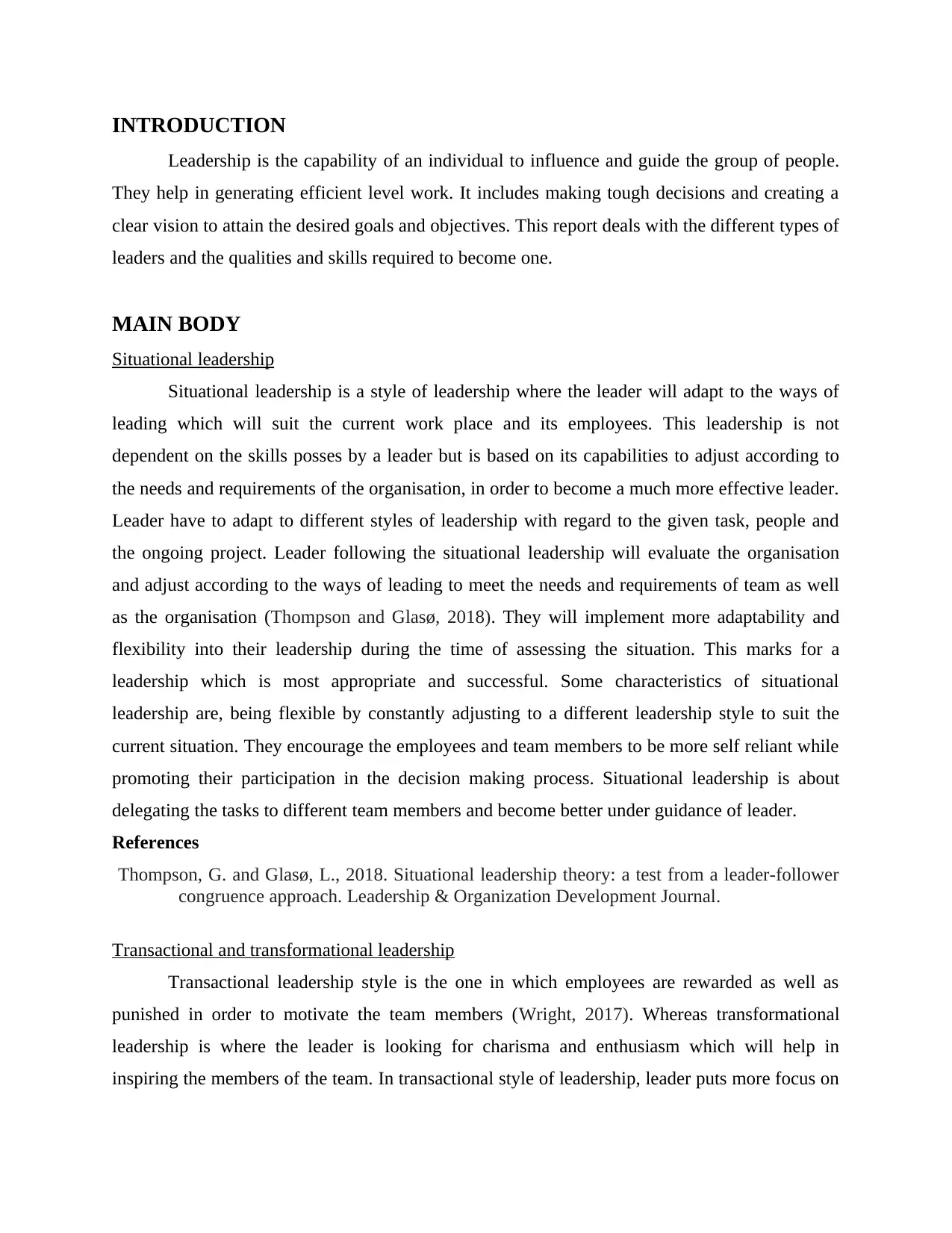
INTRODUCTION
Leadership is the capability of an individual to influence and guide the group of people.
They help in generating efficient level work. It includes making tough decisions and creating a
clear vision to attain the desired goals and objectives. This report deals with the different types of
leaders and the qualities and skills required to become one.
MAIN BODY
Situational leadership
Situational leadership is a style of leadership where the leader will adapt to the ways of
leading which will suit the current work place and its employees. This leadership is not
dependent on the skills posses by a leader but is based on its capabilities to adjust according to
the needs and requirements of the organisation, in order to become a much more effective leader.
Leader have to adapt to different styles of leadership with regard to the given task, people and
the ongoing project. Leader following the situational leadership will evaluate the organisation
and adjust according to the ways of leading to meet the needs and requirements of team as well
as the organisation (Thompson and Glasø, 2018). They will implement more adaptability and
flexibility into their leadership during the time of assessing the situation. This marks for a
leadership which is most appropriate and successful. Some characteristics of situational
leadership are, being flexible by constantly adjusting to a different leadership style to suit the
current situation. They encourage the employees and team members to be more self reliant while
promoting their participation in the decision making process. Situational leadership is about
delegating the tasks to different team members and become better under guidance of leader.
References
Thompson, G. and Glasø, L., 2018. Situational leadership theory: a test from a leader-follower
congruence approach. Leadership & Organization Development Journal.
Transactional and transformational leadership
Transactional leadership style is the one in which employees are rewarded as well as
punished in order to motivate the team members (Wright, 2017). Whereas transformational
leadership is where the leader is looking for charisma and enthusiasm which will help in
inspiring the members of the team. In transactional style of leadership, leader puts more focus on
Leadership is the capability of an individual to influence and guide the group of people.
They help in generating efficient level work. It includes making tough decisions and creating a
clear vision to attain the desired goals and objectives. This report deals with the different types of
leaders and the qualities and skills required to become one.
MAIN BODY
Situational leadership
Situational leadership is a style of leadership where the leader will adapt to the ways of
leading which will suit the current work place and its employees. This leadership is not
dependent on the skills posses by a leader but is based on its capabilities to adjust according to
the needs and requirements of the organisation, in order to become a much more effective leader.
Leader have to adapt to different styles of leadership with regard to the given task, people and
the ongoing project. Leader following the situational leadership will evaluate the organisation
and adjust according to the ways of leading to meet the needs and requirements of team as well
as the organisation (Thompson and Glasø, 2018). They will implement more adaptability and
flexibility into their leadership during the time of assessing the situation. This marks for a
leadership which is most appropriate and successful. Some characteristics of situational
leadership are, being flexible by constantly adjusting to a different leadership style to suit the
current situation. They encourage the employees and team members to be more self reliant while
promoting their participation in the decision making process. Situational leadership is about
delegating the tasks to different team members and become better under guidance of leader.
References
Thompson, G. and Glasø, L., 2018. Situational leadership theory: a test from a leader-follower
congruence approach. Leadership & Organization Development Journal.
Transactional and transformational leadership
Transactional leadership style is the one in which employees are rewarded as well as
punished in order to motivate the team members (Wright, 2017). Whereas transformational
leadership is where the leader is looking for charisma and enthusiasm which will help in
inspiring the members of the team. In transactional style of leadership, leader puts more focus on
⊘ This is a preview!⊘
Do you want full access?
Subscribe today to unlock all pages.

Trusted by 1+ million students worldwide
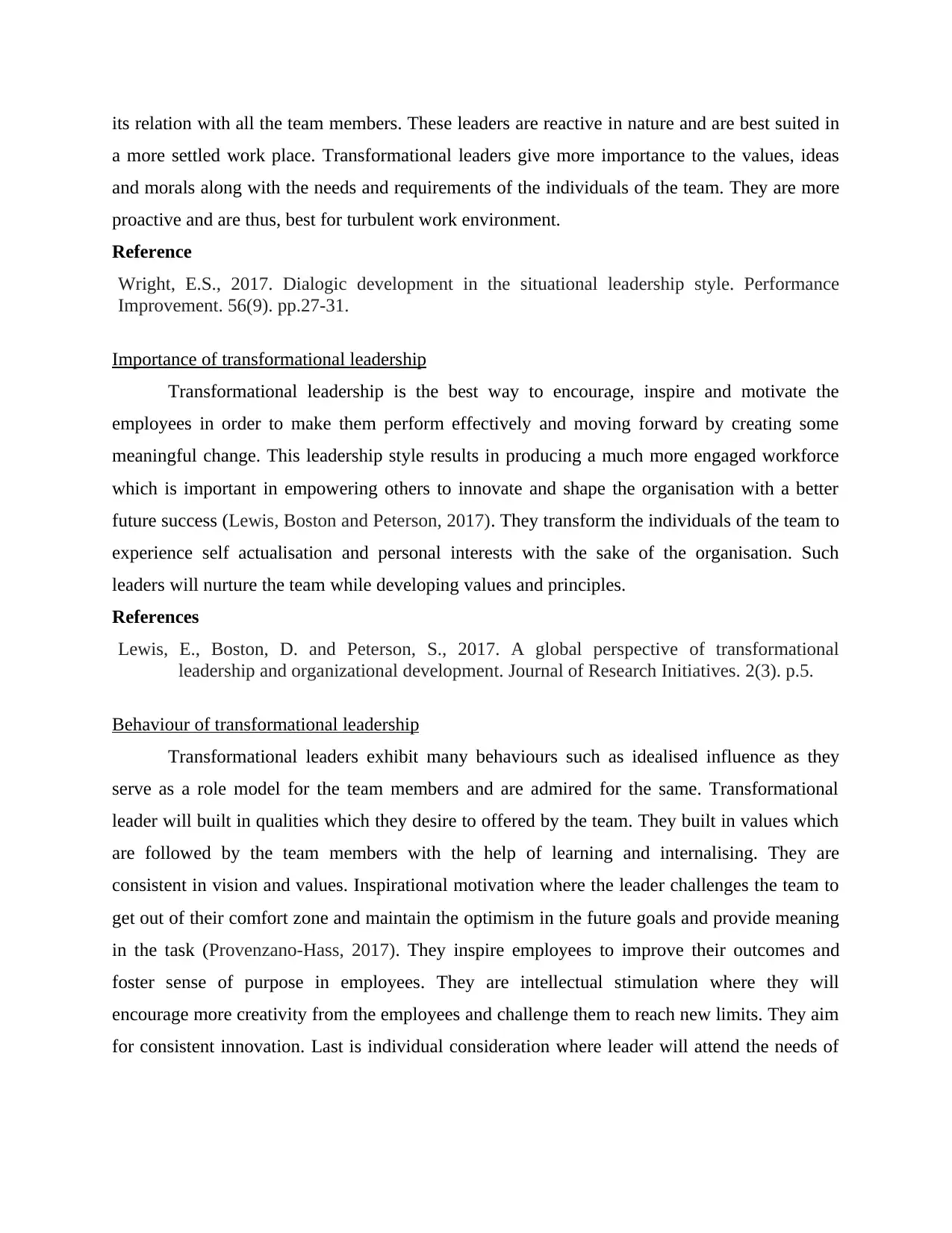
its relation with all the team members. These leaders are reactive in nature and are best suited in
a more settled work place. Transformational leaders give more importance to the values, ideas
and morals along with the needs and requirements of the individuals of the team. They are more
proactive and are thus, best for turbulent work environment.
Reference
Wright, E.S., 2017. Dialogic development in the situational leadership style. Performance
Improvement. 56(9). pp.27-31.
Importance of transformational leadership
Transformational leadership is the best way to encourage, inspire and motivate the
employees in order to make them perform effectively and moving forward by creating some
meaningful change. This leadership style results in producing a much more engaged workforce
which is important in empowering others to innovate and shape the organisation with a better
future success (Lewis, Boston and Peterson, 2017). They transform the individuals of the team to
experience self actualisation and personal interests with the sake of the organisation. Such
leaders will nurture the team while developing values and principles.
References
Lewis, E., Boston, D. and Peterson, S., 2017. A global perspective of transformational
leadership and organizational development. Journal of Research Initiatives. 2(3). p.5.
Behaviour of transformational leadership
Transformational leaders exhibit many behaviours such as idealised influence as they
serve as a role model for the team members and are admired for the same. Transformational
leader will built in qualities which they desire to offered by the team. They built in values which
are followed by the team members with the help of learning and internalising. They are
consistent in vision and values. Inspirational motivation where the leader challenges the team to
get out of their comfort zone and maintain the optimism in the future goals and provide meaning
in the task (Provenzano‐Hass, 2017). They inspire employees to improve their outcomes and
foster sense of purpose in employees. They are intellectual stimulation where they will
encourage more creativity from the employees and challenge them to reach new limits. They aim
for consistent innovation. Last is individual consideration where leader will attend the needs of
a more settled work place. Transformational leaders give more importance to the values, ideas
and morals along with the needs and requirements of the individuals of the team. They are more
proactive and are thus, best for turbulent work environment.
Reference
Wright, E.S., 2017. Dialogic development in the situational leadership style. Performance
Improvement. 56(9). pp.27-31.
Importance of transformational leadership
Transformational leadership is the best way to encourage, inspire and motivate the
employees in order to make them perform effectively and moving forward by creating some
meaningful change. This leadership style results in producing a much more engaged workforce
which is important in empowering others to innovate and shape the organisation with a better
future success (Lewis, Boston and Peterson, 2017). They transform the individuals of the team to
experience self actualisation and personal interests with the sake of the organisation. Such
leaders will nurture the team while developing values and principles.
References
Lewis, E., Boston, D. and Peterson, S., 2017. A global perspective of transformational
leadership and organizational development. Journal of Research Initiatives. 2(3). p.5.
Behaviour of transformational leadership
Transformational leaders exhibit many behaviours such as idealised influence as they
serve as a role model for the team members and are admired for the same. Transformational
leader will built in qualities which they desire to offered by the team. They built in values which
are followed by the team members with the help of learning and internalising. They are
consistent in vision and values. Inspirational motivation where the leader challenges the team to
get out of their comfort zone and maintain the optimism in the future goals and provide meaning
in the task (Provenzano‐Hass, 2017). They inspire employees to improve their outcomes and
foster sense of purpose in employees. They are intellectual stimulation where they will
encourage more creativity from the employees and challenge them to reach new limits. They aim
for consistent innovation. Last is individual consideration where leader will attend the needs of
Paraphrase This Document
Need a fresh take? Get an instant paraphrase of this document with our AI Paraphraser
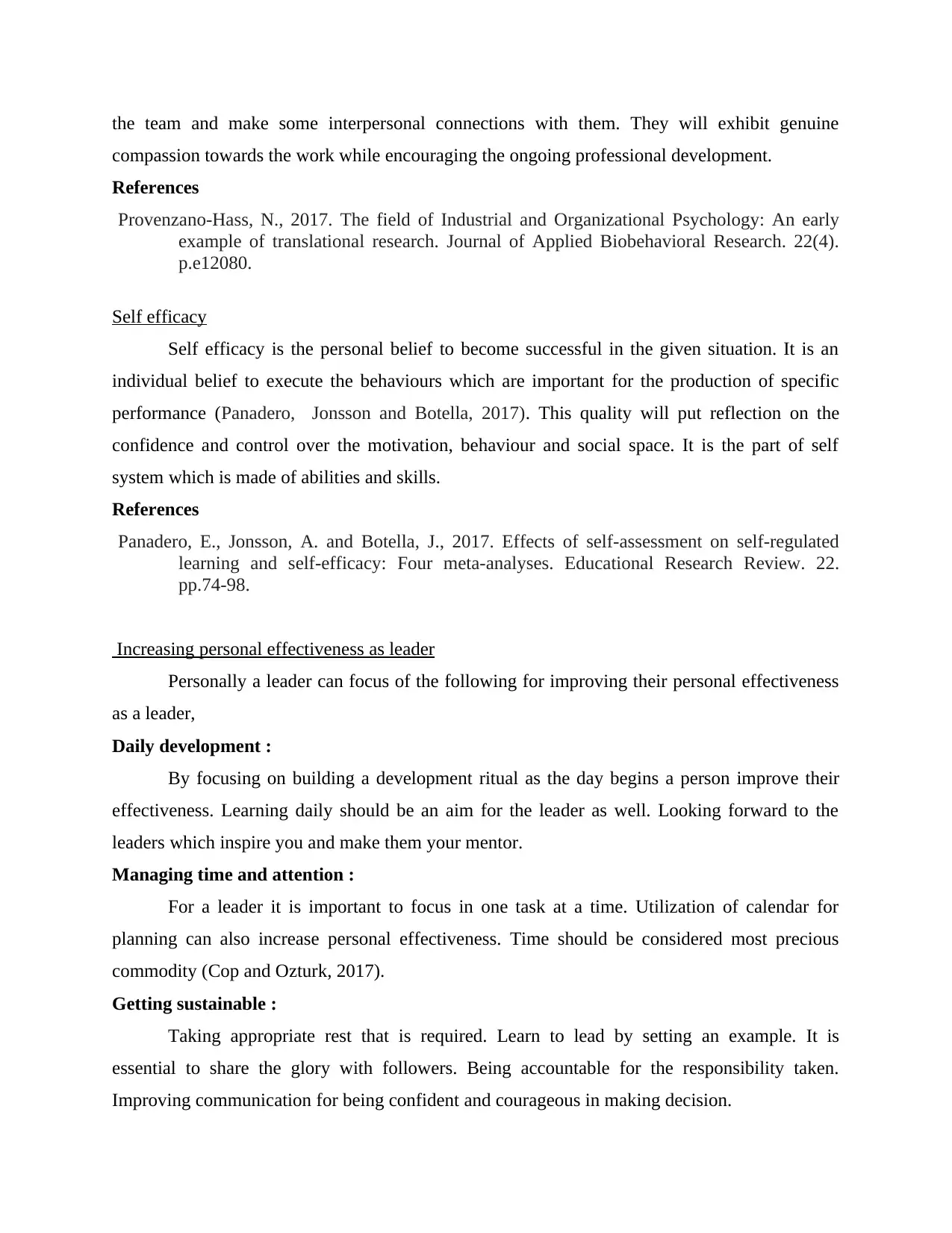
the team and make some interpersonal connections with them. They will exhibit genuine
compassion towards the work while encouraging the ongoing professional development.
References
Provenzano‐Hass, N., 2017. The field of Industrial and Organizational Psychology: An early
example of translational research. Journal of Applied Biobehavioral Research. 22(4).
p.e12080.
Self efficacy
Self efficacy is the personal belief to become successful in the given situation. It is an
individual belief to execute the behaviours which are important for the production of specific
performance (Panadero, Jonsson and Botella, 2017). This quality will put reflection on the
confidence and control over the motivation, behaviour and social space. It is the part of self
system which is made of abilities and skills.
References
Panadero, E., Jonsson, A. and Botella, J., 2017. Effects of self-assessment on self-regulated
learning and self-efficacy: Four meta-analyses. Educational Research Review. 22.
pp.74-98.
Increasing personal effectiveness as leader
Personally a leader can focus of the following for improving their personal effectiveness
as a leader,
Daily development :
By focusing on building a development ritual as the day begins a person improve their
effectiveness. Learning daily should be an aim for the leader as well. Looking forward to the
leaders which inspire you and make them your mentor.
Managing time and attention :
For a leader it is important to focus in one task at a time. Utilization of calendar for
planning can also increase personal effectiveness. Time should be considered most precious
commodity (Cop and Ozturk, 2017).
Getting sustainable :
Taking appropriate rest that is required. Learn to lead by setting an example. It is
essential to share the glory with followers. Being accountable for the responsibility taken.
Improving communication for being confident and courageous in making decision.
compassion towards the work while encouraging the ongoing professional development.
References
Provenzano‐Hass, N., 2017. The field of Industrial and Organizational Psychology: An early
example of translational research. Journal of Applied Biobehavioral Research. 22(4).
p.e12080.
Self efficacy
Self efficacy is the personal belief to become successful in the given situation. It is an
individual belief to execute the behaviours which are important for the production of specific
performance (Panadero, Jonsson and Botella, 2017). This quality will put reflection on the
confidence and control over the motivation, behaviour and social space. It is the part of self
system which is made of abilities and skills.
References
Panadero, E., Jonsson, A. and Botella, J., 2017. Effects of self-assessment on self-regulated
learning and self-efficacy: Four meta-analyses. Educational Research Review. 22.
pp.74-98.
Increasing personal effectiveness as leader
Personally a leader can focus of the following for improving their personal effectiveness
as a leader,
Daily development :
By focusing on building a development ritual as the day begins a person improve their
effectiveness. Learning daily should be an aim for the leader as well. Looking forward to the
leaders which inspire you and make them your mentor.
Managing time and attention :
For a leader it is important to focus in one task at a time. Utilization of calendar for
planning can also increase personal effectiveness. Time should be considered most precious
commodity (Cop and Ozturk, 2017).
Getting sustainable :
Taking appropriate rest that is required. Learn to lead by setting an example. It is
essential to share the glory with followers. Being accountable for the responsibility taken.
Improving communication for being confident and courageous in making decision.

References
Cop, S. and Ozturk, Y., 2017. The impact of leader-member exchange on organizational silence:
A case study on hotel managements. Journal of Business Research-Turk. 9(2). pp.37-
68.
Qualities of servant leadership
Servant leadership is not about the style of leadership but the way of behaving which is
adopted over time. They focus on the needs of its people and not their feelings. Some of the
qualities of servant leadership are:
Empathy: They have the ability to identify and understand the feelings and emotions which the
individuals of the team are going through. This type of leaders will take care about its people and
will experience the emotions which will be same as that of others.
Listening: Such leaders will pay good amount of attention on what other people are saying
(Hiwa, Durmaz and Demir, 2021). This way they will achieve a complete understanding of all
the situations which they are dealing with. Servant leaders will use the form of active listening in
resolving the conflicts and counselling other people while imparting training.
Persuasive: Being a servant leader is very easy to influence the opinions and actions of the other
people with the help of persuasive skills. This quality of servant leaders is very helpful during
the time of negotiations with other business partners, customers and also the stakeholders. They
focus on the welfare of other people and use this ability to influence other people in a positive
way.
References
Hiwa, H., Durmaz, O. and Demir, S., 2021. Leadership Styles and their effects on
Organizational Effectiveness. Black Sea Journal of Management and Marketing. 2(2).
pp.26-33.
Competencies within an organisation
Management of time and priority setting: Having a proper use of time and prioritising
the give tasks helps in providing better quality of work. Prioritising the work helps in putting
more focus on the important tasks and keeping them under high priority will help in working on
them with complete attention and focus. Time management is very important in setting the
priorities which in turn will allow in deciding the tasks and putting the focus on things which are
Cop, S. and Ozturk, Y., 2017. The impact of leader-member exchange on organizational silence:
A case study on hotel managements. Journal of Business Research-Turk. 9(2). pp.37-
68.
Qualities of servant leadership
Servant leadership is not about the style of leadership but the way of behaving which is
adopted over time. They focus on the needs of its people and not their feelings. Some of the
qualities of servant leadership are:
Empathy: They have the ability to identify and understand the feelings and emotions which the
individuals of the team are going through. This type of leaders will take care about its people and
will experience the emotions which will be same as that of others.
Listening: Such leaders will pay good amount of attention on what other people are saying
(Hiwa, Durmaz and Demir, 2021). This way they will achieve a complete understanding of all
the situations which they are dealing with. Servant leaders will use the form of active listening in
resolving the conflicts and counselling other people while imparting training.
Persuasive: Being a servant leader is very easy to influence the opinions and actions of the other
people with the help of persuasive skills. This quality of servant leaders is very helpful during
the time of negotiations with other business partners, customers and also the stakeholders. They
focus on the welfare of other people and use this ability to influence other people in a positive
way.
References
Hiwa, H., Durmaz, O. and Demir, S., 2021. Leadership Styles and their effects on
Organizational Effectiveness. Black Sea Journal of Management and Marketing. 2(2).
pp.26-33.
Competencies within an organisation
Management of time and priority setting: Having a proper use of time and prioritising
the give tasks helps in providing better quality of work. Prioritising the work helps in putting
more focus on the important tasks and keeping them under high priority will help in working on
them with complete attention and focus. Time management is very important in setting the
priorities which in turn will allow in deciding the tasks and putting the focus on things which are
⊘ This is a preview!⊘
Do you want full access?
Subscribe today to unlock all pages.

Trusted by 1+ million students worldwide
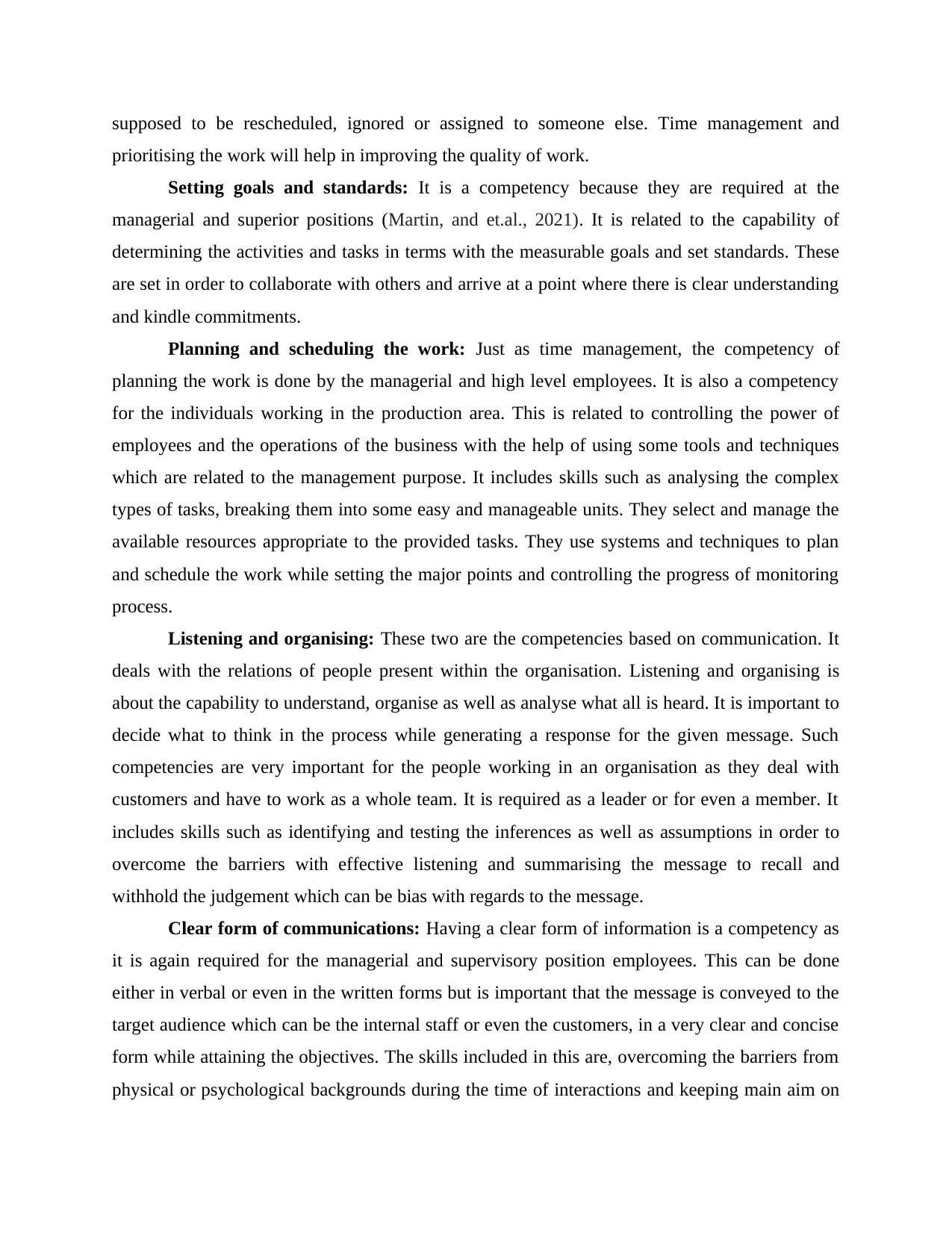
supposed to be rescheduled, ignored or assigned to someone else. Time management and
prioritising the work will help in improving the quality of work.
Setting goals and standards: It is a competency because they are required at the
managerial and superior positions (Martin, and et.al., 2021). It is related to the capability of
determining the activities and tasks in terms with the measurable goals and set standards. These
are set in order to collaborate with others and arrive at a point where there is clear understanding
and kindle commitments.
Planning and scheduling the work: Just as time management, the competency of
planning the work is done by the managerial and high level employees. It is also a competency
for the individuals working in the production area. This is related to controlling the power of
employees and the operations of the business with the help of using some tools and techniques
which are related to the management purpose. It includes skills such as analysing the complex
types of tasks, breaking them into some easy and manageable units. They select and manage the
available resources appropriate to the provided tasks. They use systems and techniques to plan
and schedule the work while setting the major points and controlling the progress of monitoring
process.
Listening and organising: These two are the competencies based on communication. It
deals with the relations of people present within the organisation. Listening and organising is
about the capability to understand, organise as well as analyse what all is heard. It is important to
decide what to think in the process while generating a response for the given message. Such
competencies are very important for the people working in an organisation as they deal with
customers and have to work as a whole team. It is required as a leader or for even a member. It
includes skills such as identifying and testing the inferences as well as assumptions in order to
overcome the barriers with effective listening and summarising the message to recall and
withhold the judgement which can be bias with regards to the message.
Clear form of communications: Having a clear form of information is a competency as
it is again required for the managerial and supervisory position employees. This can be done
either in verbal or even in the written forms but is important that the message is conveyed to the
target audience which can be the internal staff or even the customers, in a very clear and concise
form while attaining the objectives. The skills included in this are, overcoming the barriers from
physical or psychological backgrounds during the time of interactions and keeping main aim on
prioritising the work will help in improving the quality of work.
Setting goals and standards: It is a competency because they are required at the
managerial and superior positions (Martin, and et.al., 2021). It is related to the capability of
determining the activities and tasks in terms with the measurable goals and set standards. These
are set in order to collaborate with others and arrive at a point where there is clear understanding
and kindle commitments.
Planning and scheduling the work: Just as time management, the competency of
planning the work is done by the managerial and high level employees. It is also a competency
for the individuals working in the production area. This is related to controlling the power of
employees and the operations of the business with the help of using some tools and techniques
which are related to the management purpose. It includes skills such as analysing the complex
types of tasks, breaking them into some easy and manageable units. They select and manage the
available resources appropriate to the provided tasks. They use systems and techniques to plan
and schedule the work while setting the major points and controlling the progress of monitoring
process.
Listening and organising: These two are the competencies based on communication. It
deals with the relations of people present within the organisation. Listening and organising is
about the capability to understand, organise as well as analyse what all is heard. It is important to
decide what to think in the process while generating a response for the given message. Such
competencies are very important for the people working in an organisation as they deal with
customers and have to work as a whole team. It is required as a leader or for even a member. It
includes skills such as identifying and testing the inferences as well as assumptions in order to
overcome the barriers with effective listening and summarising the message to recall and
withhold the judgement which can be bias with regards to the message.
Clear form of communications: Having a clear form of information is a competency as
it is again required for the managerial and supervisory position employees. This can be done
either in verbal or even in the written forms but is important that the message is conveyed to the
target audience which can be the internal staff or even the customers, in a very clear and concise
form while attaining the objectives. The skills included in this are, overcoming the barriers from
physical or psychological backgrounds during the time of interactions and keeping main aim on
Paraphrase This Document
Need a fresh take? Get an instant paraphrase of this document with our AI Paraphraser
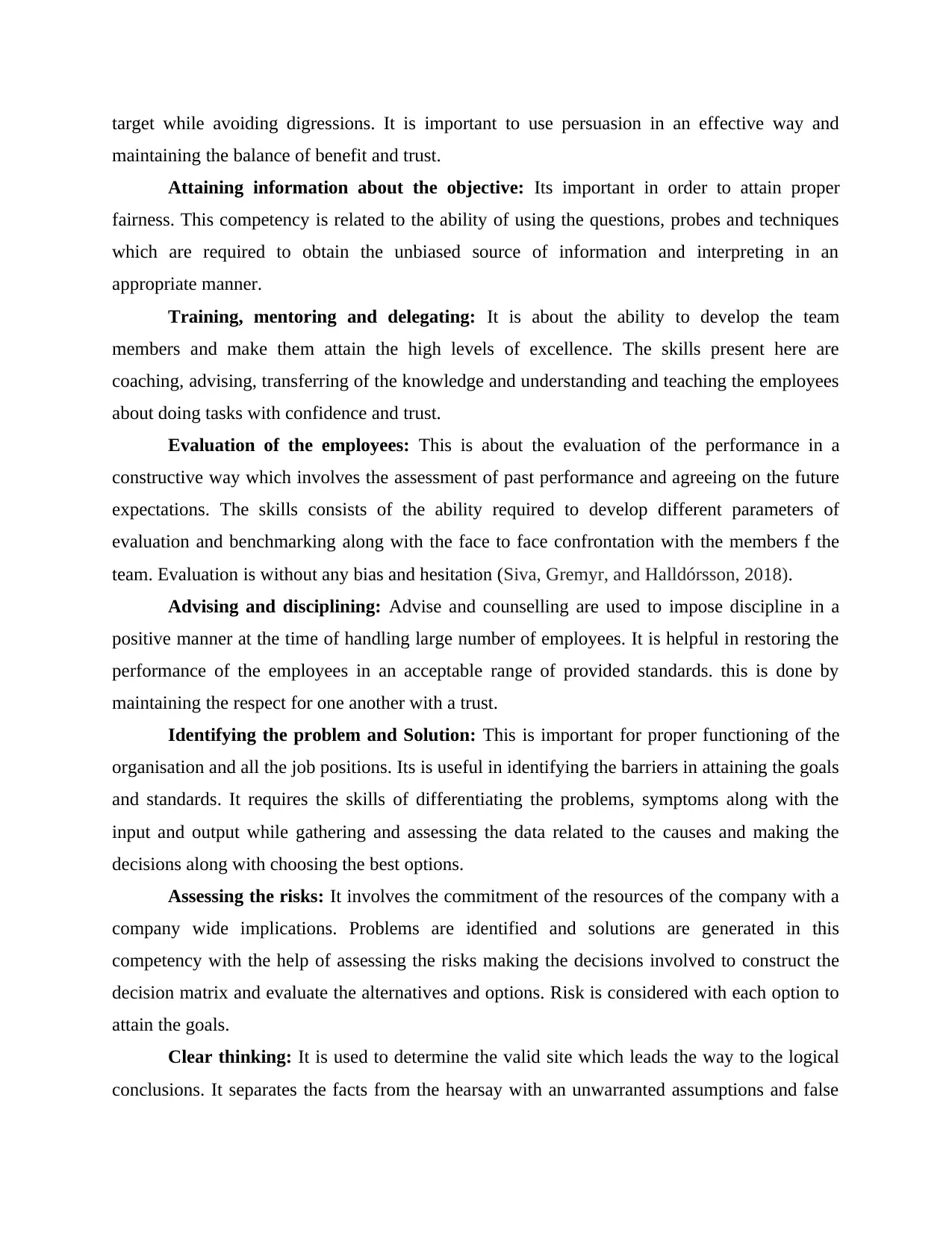
target while avoiding digressions. It is important to use persuasion in an effective way and
maintaining the balance of benefit and trust.
Attaining information about the objective: Its important in order to attain proper
fairness. This competency is related to the ability of using the questions, probes and techniques
which are required to obtain the unbiased source of information and interpreting in an
appropriate manner.
Training, mentoring and delegating: It is about the ability to develop the team
members and make them attain the high levels of excellence. The skills present here are
coaching, advising, transferring of the knowledge and understanding and teaching the employees
about doing tasks with confidence and trust.
Evaluation of the employees: This is about the evaluation of the performance in a
constructive way which involves the assessment of past performance and agreeing on the future
expectations. The skills consists of the ability required to develop different parameters of
evaluation and benchmarking along with the face to face confrontation with the members f the
team. Evaluation is without any bias and hesitation (Siva, Gremyr, and Halldórsson, 2018).
Advising and disciplining: Advise and counselling are used to impose discipline in a
positive manner at the time of handling large number of employees. It is helpful in restoring the
performance of the employees in an acceptable range of provided standards. this is done by
maintaining the respect for one another with a trust.
Identifying the problem and Solution: This is important for proper functioning of the
organisation and all the job positions. Its is useful in identifying the barriers in attaining the goals
and standards. It requires the skills of differentiating the problems, symptoms along with the
input and output while gathering and assessing the data related to the causes and making the
decisions along with choosing the best options.
Assessing the risks: It involves the commitment of the resources of the company with a
company wide implications. Problems are identified and solutions are generated in this
competency with the help of assessing the risks making the decisions involved to construct the
decision matrix and evaluate the alternatives and options. Risk is considered with each option to
attain the goals.
Clear thinking: It is used to determine the valid site which leads the way to the logical
conclusions. It separates the facts from the hearsay with an unwarranted assumptions and false
maintaining the balance of benefit and trust.
Attaining information about the objective: Its important in order to attain proper
fairness. This competency is related to the ability of using the questions, probes and techniques
which are required to obtain the unbiased source of information and interpreting in an
appropriate manner.
Training, mentoring and delegating: It is about the ability to develop the team
members and make them attain the high levels of excellence. The skills present here are
coaching, advising, transferring of the knowledge and understanding and teaching the employees
about doing tasks with confidence and trust.
Evaluation of the employees: This is about the evaluation of the performance in a
constructive way which involves the assessment of past performance and agreeing on the future
expectations. The skills consists of the ability required to develop different parameters of
evaluation and benchmarking along with the face to face confrontation with the members f the
team. Evaluation is without any bias and hesitation (Siva, Gremyr, and Halldórsson, 2018).
Advising and disciplining: Advise and counselling are used to impose discipline in a
positive manner at the time of handling large number of employees. It is helpful in restoring the
performance of the employees in an acceptable range of provided standards. this is done by
maintaining the respect for one another with a trust.
Identifying the problem and Solution: This is important for proper functioning of the
organisation and all the job positions. Its is useful in identifying the barriers in attaining the goals
and standards. It requires the skills of differentiating the problems, symptoms along with the
input and output while gathering and assessing the data related to the causes and making the
decisions along with choosing the best options.
Assessing the risks: It involves the commitment of the resources of the company with a
company wide implications. Problems are identified and solutions are generated in this
competency with the help of assessing the risks making the decisions involved to construct the
decision matrix and evaluate the alternatives and options. Risk is considered with each option to
attain the goals.
Clear thinking: It is used to determine the valid site which leads the way to the logical
conclusions. It separates the facts from the hearsay with an unwarranted assumptions and false

inferences. It is used to apply inductive and deductive approach to form the conclusions based
on the information which is not sufficient.
References
Martin, and et.al., 2021. Towards a quality management competence framework: exploring
needed competencies in quality management. Total Quality Management & Business
Excellence. 32(3-4). pp.359-378.
Siva, V., Gremyr, I. and Halldórsson, Á., 2018. Organising sustainability competencies through
quality management: Integration or specialisation. Sustainability. 10(5). p.1326.
Ways to strengthen and cultivate the work relations
Relations at work are related to the interactions between the colleagues and is very
important to attain success in career. Better relations at workplace will result in having more
level of satisfaction and increased form of comfort. The different ways to help in strengthening
and cultivating the workplace relations are:
Stay connected: In this modern business world which is working at a fast pace, it is not easy to
stay in touch and with the contacts. It is important to take out some time to develop business
relations in order to stay strong, it is important to be cultivated and properly nourished.
Scheduling helps a lot in order to keep up with the business connections and earn more face time
(Paulienė, 2017). Staying connected includes having to attend the social events, communication
via mail to catch up and also congratulating the colleague for their promotion. Staying connected
is important to maintain and grow the professional relations.
Ask questions and listen: Active listening is very helpful in allowing the individuals to learn
more about colleagues and build relation in the process, which is very important. Asking
questions about the personal life of the personal life of the co-workers as well as their goals and
requirements is a way of showing a sense of interest in them. This provides an opportunity which
is helpful in sharing the details of personal life. It also helps in encouraging open communication
which creates a comfortable space within the work place. This is great to earn more points in
being a good communicator.
References
Paulienė, R., 2017. Interaction between managerial competencies and leadership in business
organisations. Regional Formation and Development Studies. 21(1). pp.97-107.
on the information which is not sufficient.
References
Martin, and et.al., 2021. Towards a quality management competence framework: exploring
needed competencies in quality management. Total Quality Management & Business
Excellence. 32(3-4). pp.359-378.
Siva, V., Gremyr, I. and Halldórsson, Á., 2018. Organising sustainability competencies through
quality management: Integration or specialisation. Sustainability. 10(5). p.1326.
Ways to strengthen and cultivate the work relations
Relations at work are related to the interactions between the colleagues and is very
important to attain success in career. Better relations at workplace will result in having more
level of satisfaction and increased form of comfort. The different ways to help in strengthening
and cultivating the workplace relations are:
Stay connected: In this modern business world which is working at a fast pace, it is not easy to
stay in touch and with the contacts. It is important to take out some time to develop business
relations in order to stay strong, it is important to be cultivated and properly nourished.
Scheduling helps a lot in order to keep up with the business connections and earn more face time
(Paulienė, 2017). Staying connected includes having to attend the social events, communication
via mail to catch up and also congratulating the colleague for their promotion. Staying connected
is important to maintain and grow the professional relations.
Ask questions and listen: Active listening is very helpful in allowing the individuals to learn
more about colleagues and build relation in the process, which is very important. Asking
questions about the personal life of the personal life of the co-workers as well as their goals and
requirements is a way of showing a sense of interest in them. This provides an opportunity which
is helpful in sharing the details of personal life. It also helps in encouraging open communication
which creates a comfortable space within the work place. This is great to earn more points in
being a good communicator.
References
Paulienė, R., 2017. Interaction between managerial competencies and leadership in business
organisations. Regional Formation and Development Studies. 21(1). pp.97-107.
⊘ This is a preview!⊘
Do you want full access?
Subscribe today to unlock all pages.

Trusted by 1+ million students worldwide
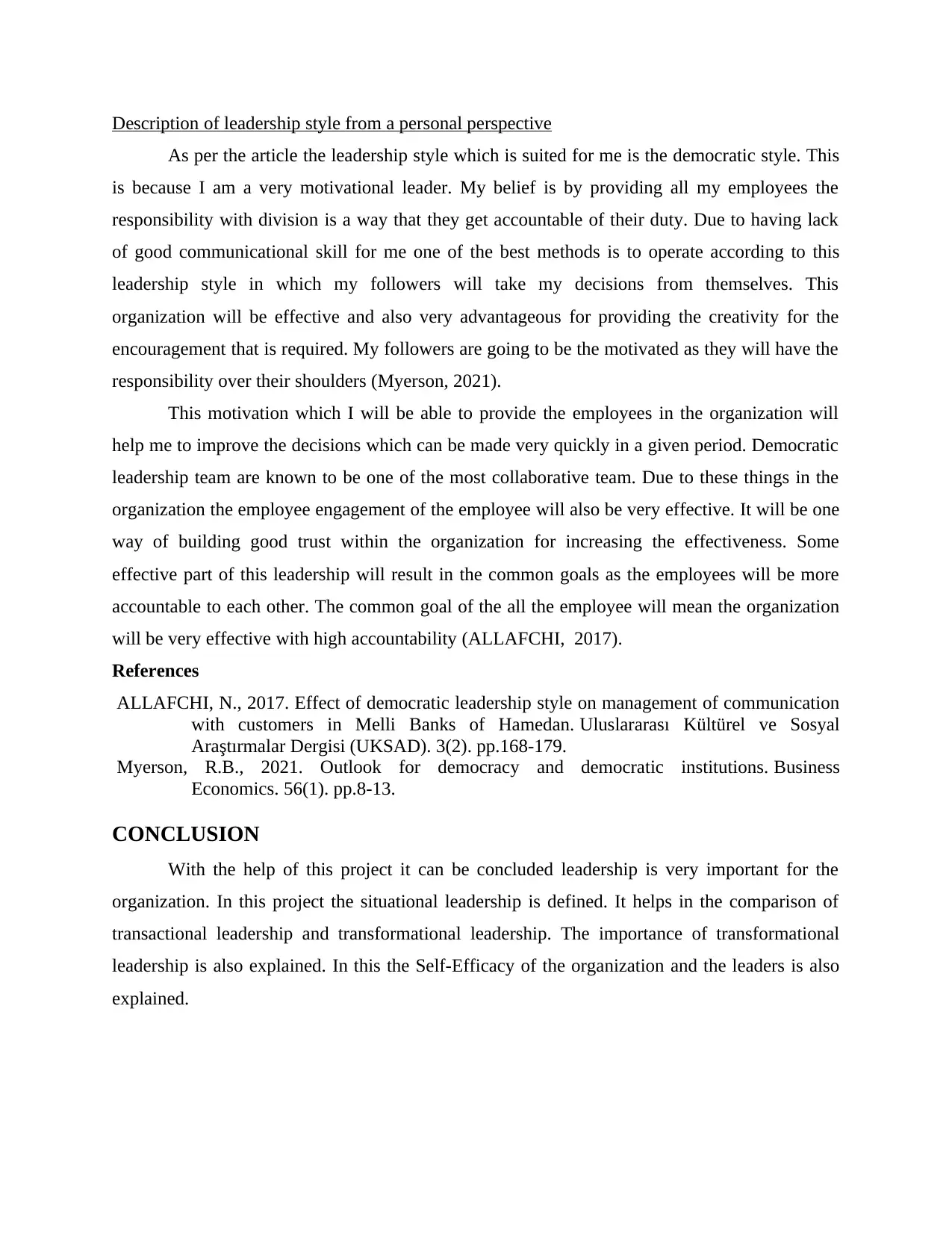
Description of leadership style from a personal perspective
As per the article the leadership style which is suited for me is the democratic style. This
is because I am a very motivational leader. My belief is by providing all my employees the
responsibility with division is a way that they get accountable of their duty. Due to having lack
of good communicational skill for me one of the best methods is to operate according to this
leadership style in which my followers will take my decisions from themselves. This
organization will be effective and also very advantageous for providing the creativity for the
encouragement that is required. My followers are going to be the motivated as they will have the
responsibility over their shoulders (Myerson, 2021).
This motivation which I will be able to provide the employees in the organization will
help me to improve the decisions which can be made very quickly in a given period. Democratic
leadership team are known to be one of the most collaborative team. Due to these things in the
organization the employee engagement of the employee will also be very effective. It will be one
way of building good trust within the organization for increasing the effectiveness. Some
effective part of this leadership will result in the common goals as the employees will be more
accountable to each other. The common goal of the all the employee will mean the organization
will be very effective with high accountability (ALLAFCHI, 2017).
References
ALLAFCHI, N., 2017. Effect of democratic leadership style on management of communication
with customers in Melli Banks of Hamedan. Uluslararası Kültürel ve Sosyal
Araştırmalar Dergisi (UKSAD). 3(2). pp.168-179.
Myerson, R.B., 2021. Outlook for democracy and democratic institutions. Business
Economics. 56(1). pp.8-13.
CONCLUSION
With the help of this project it can be concluded leadership is very important for the
organization. In this project the situational leadership is defined. It helps in the comparison of
transactional leadership and transformational leadership. The importance of transformational
leadership is also explained. In this the Self-Efficacy of the organization and the leaders is also
explained.
As per the article the leadership style which is suited for me is the democratic style. This
is because I am a very motivational leader. My belief is by providing all my employees the
responsibility with division is a way that they get accountable of their duty. Due to having lack
of good communicational skill for me one of the best methods is to operate according to this
leadership style in which my followers will take my decisions from themselves. This
organization will be effective and also very advantageous for providing the creativity for the
encouragement that is required. My followers are going to be the motivated as they will have the
responsibility over their shoulders (Myerson, 2021).
This motivation which I will be able to provide the employees in the organization will
help me to improve the decisions which can be made very quickly in a given period. Democratic
leadership team are known to be one of the most collaborative team. Due to these things in the
organization the employee engagement of the employee will also be very effective. It will be one
way of building good trust within the organization for increasing the effectiveness. Some
effective part of this leadership will result in the common goals as the employees will be more
accountable to each other. The common goal of the all the employee will mean the organization
will be very effective with high accountability (ALLAFCHI, 2017).
References
ALLAFCHI, N., 2017. Effect of democratic leadership style on management of communication
with customers in Melli Banks of Hamedan. Uluslararası Kültürel ve Sosyal
Araştırmalar Dergisi (UKSAD). 3(2). pp.168-179.
Myerson, R.B., 2021. Outlook for democracy and democratic institutions. Business
Economics. 56(1). pp.8-13.
CONCLUSION
With the help of this project it can be concluded leadership is very important for the
organization. In this project the situational leadership is defined. It helps in the comparison of
transactional leadership and transformational leadership. The importance of transformational
leadership is also explained. In this the Self-Efficacy of the organization and the leaders is also
explained.
Paraphrase This Document
Need a fresh take? Get an instant paraphrase of this document with our AI Paraphraser


⊘ This is a preview!⊘
Do you want full access?
Subscribe today to unlock all pages.

Trusted by 1+ million students worldwide
1 out of 12
Related Documents
Your All-in-One AI-Powered Toolkit for Academic Success.
+13062052269
info@desklib.com
Available 24*7 on WhatsApp / Email
![[object Object]](/_next/static/media/star-bottom.7253800d.svg)
Unlock your academic potential
Copyright © 2020–2025 A2Z Services. All Rights Reserved. Developed and managed by ZUCOL.



